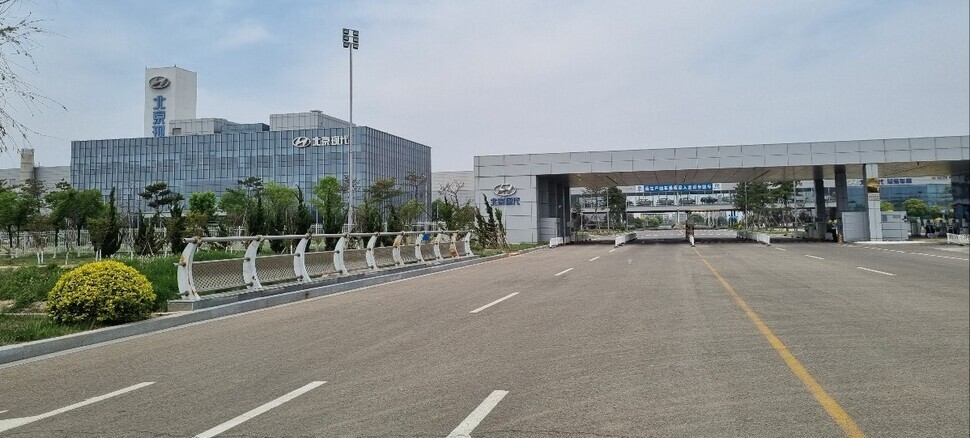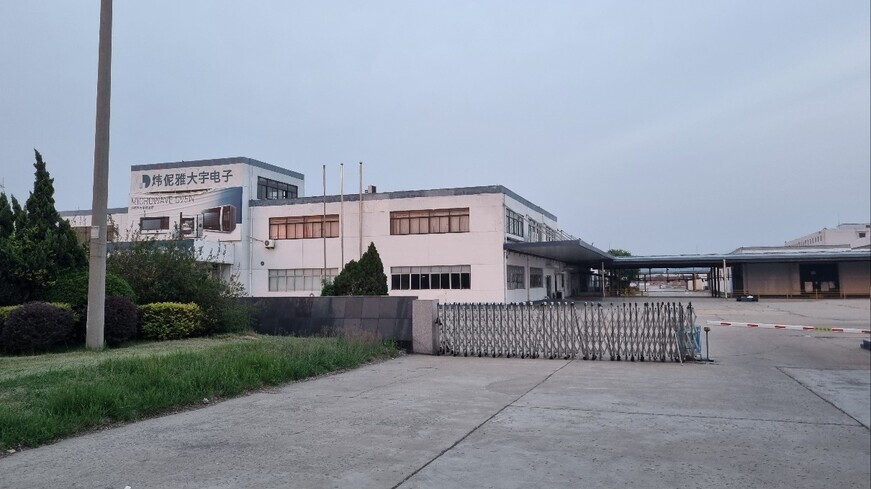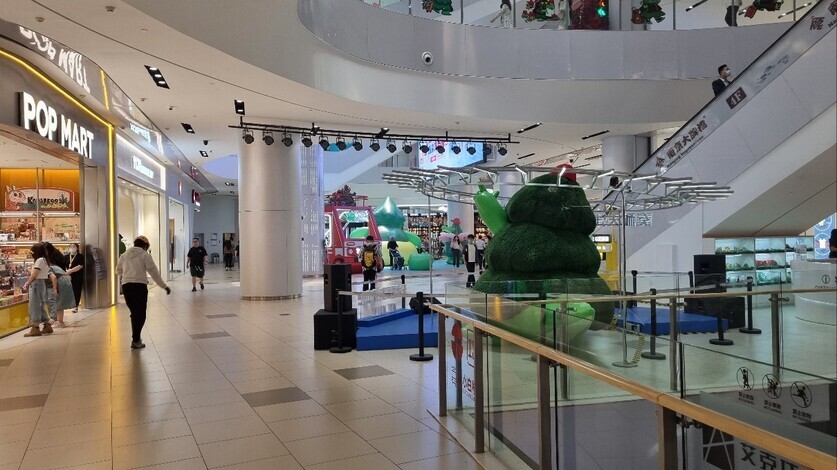hankyoreh
Links to other country sites 다른 나라 사이트 링크
[Reportage] Idle factories, shuttered stores: Why Korean businesses are closing shop in the Chinese market

On the morning of May 11, a resident of Cangzhou mentioned hearing disturbing rumors that the Hyundai Motor Company would soon be closing its factory there.
“Back when Hyundai Motors built the factory in 2016, people in the area were overjoyed, but now they’re apparently going to shut it down after just seven years. It’s a real shame,” the resident remarked.
It was a weekday morning, but hardly any cars or people could be seen moving inside the Hyundai plant in Cangzhou, which covers 2 square kilometers on the outskirts of the city. Cangzhou is a small city in Hebei Province, about 200 kilometers south of the Chinese capital of Beijing.
Chinese cars push out HyundaiIt was much the same at a Hyundai Mobis factory positioned on one side of the factory park. “Nothing is being produced today,” remarked a security guard at the factory gate.
When I asked when production had stopped, the guard said, “They didn’t make anything yesterday, or the day before either. I was told production would resume tomorrow, but nowadays the factories are quiet every day.”
Just seven years after building the factory in Cangzhou — its fourth in China — Hyundai Motors is weighing the option of shutting it down.
Along with Kia, Hyundai gained a 10% share of the Chinese automobile market (1.79 million units sold) in 2016, prompting it to build a total of five factories there. But since then, it has sold off one of the factories, and the other four are either idle or operating far below capacity.
The problem is that Hyundai and Kia’s market share in China has recently plummeted below 2% as Chinese automakers have gobbled up the difference.
The Chinese electric vehicle (EV) maker BYD moved up to No. 1 in sales in the Chinese market this year. In doing so, it overtook Volkswagen, which had held down the top spot since 2008.

Meanwhile, a Winia Electronics (formerly known as Daewoo Electronics) factory in Tianjin — about 60 kilometers north of Changzhou — stood completely empty as of the afternoon of May 11, suggesting it had been out of operation for some time. A faded “welcome” sign in Korean at the factory’s entrance attested to the fact that the site belonged to a South Korean company.
Winia produced over US$200 billion worth of items here annually, including refrigerators and washing machines. But last February, the company sold its factory to a Chinese business.
“Our stockpiles rose sharply and our production plummeted due to poor business conditions and a contraction in consumption activities,” a Winia official explained, adding that the company had “almost no production at all during the COVID-19 period.”
“We sold the factory to a Chinese company early this year,” they added.
South Korea’s sustained trade deficit with China since May 2022, together with the slump facing its businesses that have expanded into China, have put a heavy damper on its economy, which has relied on the massive Chinese market for growth over a period of more than three decades since diplomatic relations were established in August 1992.
While the most immediate factor behind South Korea’s slump has been the declining performance by the semiconductors that have historically shored up its exports, many analysts say a more fundamental issue is the fading competitiveness of South Korean products and the unnervingly hot pursuit coming from Chinese businesses.
China on frighteningly fast pace to overtake Korean manufacturersOn May 11, the Korea Chamber of Commerce and Industry (KCCI) shared findings from a survey on the business world’s perceptions of South Korea’s declining export performance with China. When asked about how businesses perceived the technology competitiveness gap relative to Chinese companies, 40.3% of respondents agreed that South Korea was not in the lead, with 36.6% rating the two countries’ levels as “similar” and 3.7% putting South Korea behind China.
Even among those who rated South Korea as being ahead of China right now, the largest percentage (38.7%) saw the lead as amounting to “three years at most.”
When asked about the growth rates for South Korea and Chinese technology over the next five years, 41.3% of respondents predicted China’s rate would surpass South Korea’s, while 35% said their rates would be similar.
The change has had an especially severe impact in Tianjin, which has been described as South Korea’s main production base in China. The number of South Korean companies operating in the city has dropped from over 2,500 in the early 2010s to just over 500 a decade later.
“The Chinese manufacturers have been catching up at a frighteningly fast pace,” explained Park Hong-hee, who chairs the local Korean association in Tianjin.
“General manufacturers have lost pretty much all of their competitiveness, and it’s looking like services and technology-intensive industries will be the only ones surviving,” he predicted.
The struggles for South Korean products haven’t been limited to automobiles or electronics. South Korean cosmetics, which had been favored by young Chinese people amid the Korean Wave, have also fallen on hard times.

Visiting the Tianjin Guomao Shopping Center on May 12 after hearing that it had a branch of Amorepacific’s medium- to low-price cosmetic brand Innisfree, I could not find the store in question.
An employee there told me, “I had heard there was a Korean cosmetics store, but right now there are only select shops for Chinese cosmetics.”
It turned out that the store pulled out in June 2021. This was part of a recent trend in China that has become known as the “guochao,” or “national trend” — a preference for domestically produced items. When asked in a KCCI survey whether they sensed a decline in preferences for South Korean items amid the guochao trend, 32.7% of respondents answered “yes.”
In 2019, Amorepacific increased its number of Innisfree stores in China to over 600 nationwide; by the end of 2022, it had had to scale that number down to 64. Unable to cope with the sliding sales, it now plans to pull the brand out of the Chinese market entirely by the first half of 2023.
An Amorepacific official acknowledged that the company “took a big hit” in sales in late 2016 amid China’s boycotts in response to South Korea’s deployment of a Terminal High Altitude Area Defense (THAAD) anti-missile system, but added that the “decisive factors” in the decision to withdraw were the “improving quality and higher sales for Chinese cosmetics.”
The official added that the company “still plans to compete in the high-end cosmetics market, where the locally produced products are less competitive.”
By Choi Hyun-june, Beijing correspondent
Please direct questions or comments to [english@hani.co.kr]

Editorial・opinion
![[Editorial] Yoon must halt procurement of SM-3 interceptor missiles [Editorial] Yoon must halt procurement of SM-3 interceptor missiles](https://flexible.img.hani.co.kr/flexible/normal/500/300/imgdb/child/2024/0501/17145495551605_1717145495195344.jpg) [Editorial] Yoon must halt procurement of SM-3 interceptor missiles
[Editorial] Yoon must halt procurement of SM-3 interceptor missiles![[Guest essay] Maybe Korea’s rapid population decline is an opportunity, not a crisis [Guest essay] Maybe Korea’s rapid population decline is an opportunity, not a crisis](https://flexible.img.hani.co.kr/flexible/normal/500/300/imgdb/original/2024/0430/9417144634983596.jpg) [Guest essay] Maybe Korea’s rapid population decline is an opportunity, not a crisis
[Guest essay] Maybe Korea’s rapid population decline is an opportunity, not a crisis- [Column] Can Yoon steer diplomacy with Russia, China back on track?
- [Column] Season 2 of special prosecutor probe may be coming to Korea soon
- [Column] Park Geun-hye déjà vu in Yoon Suk-yeol
- [Editorial] New weight of N. Korea’s nuclear threats makes dialogue all the more urgent
- [Guest essay] The real reason Korea’s new right wants to dub Rhee a founding father
- [Column] ‘Choson’: Is it time we start referring to N. Korea in its own terms?
- [Editorial] Japan’s rewriting of history with Korea has gone too far
- [Column] The president’s questionable capacity for dialogue
Most viewed articles
- 1Months and months of overdue wages are pushing migrant workers in Korea into debt
- 2Trump asks why US would defend Korea, hints at hiking Seoul’s defense cost burden
- 3[Editorial] Yoon must halt procurement of SM-3 interceptor missiles
- 4At heart of West’s handwringing over Chinese ‘overcapacity,’ a battle to lead key future industries
- 5[Guest essay] Maybe Korea’s rapid population decline is an opportunity, not a crisis
- 6Fruitless Yoon-Lee summit inflames partisan tensions in Korea
- 7First meeting between Yoon, Lee in 2 years ends without compromise or agreement
- 8Under conservative chief, Korea’s TRC brands teenage wartime massacre victims as traitors
- 9Dermatology, plastic surgery drove record medical tourism to Korea in 2023
- 10[Column] Park Geun-hye déjà vu in Yoon Suk-yeol